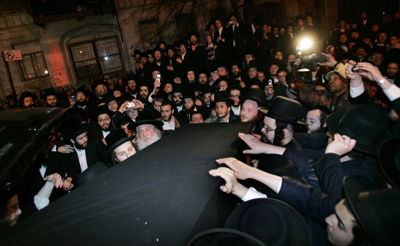Moses Teitelbaum, the grand rabbi of the Satmar Hasidim, one of the world's
largest and fastest-growing sects of Orthodox Jews, died in Manhattan April 24,
2006. He was 91 and lived in Williamsburg, Brooklyn.

The casket carrying
the remains of ultra-orthodox Jewish Rabbi Moses Teitelbaum of the Satmar
Hassidim is carried through a crush of followers from his home to a hearse
for his funeral service in the Williamburg section of Brooklyn, New York
April 24, 2006. Teitelbaum, the spiritual leader of the largest Hassidic
Jewish sect in the United States, died at age 91 on Monday.
[Reuters] |
His family, through spokesmen, said he died at Mount Sinai Medical Center,
where he had been hospitalized for a number of ailments.
Rabbi Teitelbaum became leader of the Satmars in 1980, succeeding his uncle
Joel Teitelbaum. In Hasidism, a mystical brand of Orthodox Judaism, the grand
rabbi is revered as a kinglike link to God, holding vast sway over members'
lives.
Joel Teitelbaum had transplanted the tattered remnants of Satmar from
post-Holocaust Europe to Williamsburg, giving the sect new life. Under Moses
Teitelbaum, Satmar more than doubled its ranks, to an estimated 100,000
worldwide, building schools and expanding real estate holdings that are now
worth hundreds of millions of dollars.
Rabbi Solomon Gelbman, a Satmar historian, said that Rabbi Teitelbaum, known
to his followers by his Hebrew name, Moshe, had likened himself to the biblical
Jacob, who considered himself custodian of the great works begun by Isaac and
Abraham before him.
"Jacob said, 'I'm not digging any new wells; I'm just watching the wells that
the father and the grandfather dug, that they should continue to produce clean
water,' " Rabbi Gelbman said. "Rabbi Moshe said the same thing: 'Rabbi Joel dug
the wells. I'm just tending them.' "
The last years of Rabbi Teitelbaum's leadership were marred by a bitter
succession dispute ¡ª still unresolved ¡ª between two of his sons, Rabbi Aaron
Teitelbaum and Rabbi Zalmen Teitelbaum. The feud began in 1999, when the grand
rabbi chose Zalmen, his third son, to take over the sect's main congregation in
Williamsburg. He had previously named Aaron, the eldest son, to run the
second-largest Satmar congregation, in Kiryas Joel, N.Y.
Supporters of the first-born brother never accepted Zalmen's appointment as
legitimate, and lawsuits followed, as did sometimes violent confrontations
between partisans in the streets and synagogues of Williamsburg.
Even as Rabbi Teitelbaum lay ill at Mount Sinai in recent weeks, Rabbi Aaron
and Rabbi Zalmen were negotiating through intermediaries over who would speak at
his funeral, and in what order. Thousands attended the ceremony last night in
Williamsburg.
In addition to Aaron and Zalmen, Rabbi Teitelbaum is survived by his wife,
Pessel Leah; two other sons, Lipa and Shulem, also rabbis; two daughters, Bracha
Meisels and Hendy Halberstam; and at least 86 grandchildren and
great-grandchildren.
The Satmars, who originated in Satu Mare, Romania, are among the more
isolationist of the Hasidic sects, which are named for the Eastern European
towns that gave birth to them. Unlike most Hasidim, Satmars are staunchly
anti-Zionist.
Moses Teitelbaum, named for the 18th-century founder of the Satmar dynasty,
Moshe Teitelbaum, was born into rabbinic royalty in Ujfeherto, in what is now
eastern Hungary, on Nov. 17, 1914. When the region fell to the Nazis, Rabbi
Teitelbaum, then teaching at a yeshiva, was sent to Auschwitz with his wife and
three children. Only the rabbi survived. After the war, he remarried and moved
to the United States, where Joel Teitelbaum had re-established the sect. Moses
founded a congregation in Borough Park, Brooklyn.
After Joel Teitelbaum died childless in 1979, the Satmars named Moses the
rebbe, and he moved into the sect's seat in Williamsburg.
By the time Moses died, the Williamsburg enclave had a population of about
35,000, spilling over into adjacent neighborhoods. The settlement in Kiryas
Joel, in Orange County, had grown to more than 15,000 people after being
established by a few settlers in the last years of Joel's life.
Moses Teitelbaum "took a moderately successful Hasidic group and really
nourished its growth," said David M. Pollock, associate executive director of
the Jewish Community Relations Council. "It's now the largest Hasidic group in
the United States."
If the Satmar schools in New York were a public school system, it would be
the fourth-largest system in the state, after those of New York City, Buffalo
and Rochester.
Rabbi Teitelbaum's leadership was such that even as the sect has threatened
to split over the succession battle, it has continued to grow, said Samuel C.
Heilman, a distinguished professor of sociology at Queens College.
"One of the signs of the Satmars' strength," Professor Heilman said, "is that
in spite of this internal conflict, they're not on the verge of falling apart."